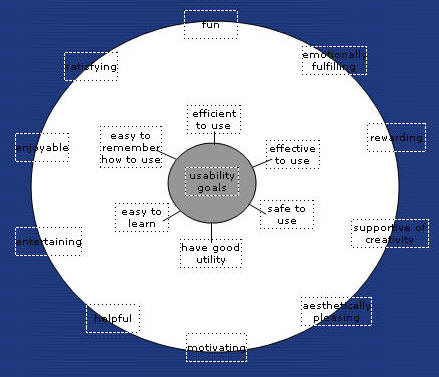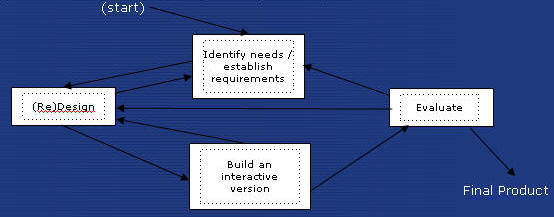
usability goals: at center of Interaction Design
user-experience goals: outer ring of diagram (secondary to usability goals)
Interaction Design
From Preece's book- see book notes for extra information
Interaction Design involves four basic activities:
Evaluating what has been built is the heart of Interaction Design

usability goals: at center of Interaction Design
user-experience goals: outer ring of diagram (secondary to usability
goals)
Three characteristics of the Interaction Design Process:
- Usability Goals: concerned with meeting a usability criteria (e.g. efficiency)
- Effectiveness - how gooa system is at doing what it is supposed to
- Efficiency - the way a system supports users in carryign out their tasks
- Safety - protectign the users from dangerous conditions / undesirable situations
- Utility - extent to which the system provides the right kind of functionality so that users can do what they need or want to do
- Learnability - how easy a system is to learn to use
- Memorability - how easy a system is to remember how to use, once learned
- User Experience Goals: User experience is what the interaction with the system feels like to the users (subjectively)
- Satisfying; enjoyable; fun; entertaining; helpful; motivating; aesthetically pleasing; support creativity; rewarding; emotionally fulfilling
Interaction design is an ITERATIVE PROCESS, involving:
cycling through various design processes and different levels of detail
thinking through a design problem
understanding users needs
coming up with possible models
prototyping models
evaluating them
thinking about design implications
making changes
etc...
The book describes ways of DOING INTERACTION DESIGN
- First pass: thinking about the problem space
- Second pass: more extensive information gathering about users’ needs and problems
- Third pass: continue explicating the requirements through models
- Fourth pass: Fleshing out models using variety of user-centered methods. Such as: prototyping, storyboarding, physical objects, informally asking users what they think.
Issues in testing prototypes:
Physical design decisions come out of conceptual decisions (i.e. what information, how to structure graphical objects, what feedback navigation and mechanisms, what kinds of icons…).
A simple lifecycle model for interaction design: see p. 186, Fig. 6.7

(note how the above principles apply to this model)
Summary of the Interaction Design Process:
There are four basic activities in the
interactive design process:
1. Identify needs and establish requirements
2. Develop ([re]design) alternative designs that meet those requirements
3. Build interactive versions of the designs so that they can be
communicated and assessed
4. Evaluate them
These are permeated with three principles:
1. Involve users early in the design process and evaluation of the
artifact
2. Define quantifiable & measurable usability criteria
3. Iteration is inevitable
Key characteristics of the interaction design process are explicit incorporation of user involvement, iteration and specific usability criteria.
Before you can begin to establish requirements, you must understand who the users are and what their goals are in using the device.
Looking at others' designs provides useful inspiration and encourages designers to consider alternative design solutions, which is key to effective design.
Usability criteria, technical feasibility, and users' feedback on prototypes can all be used to choose among alternatives.
Prototyping is a useful technique for facilitating user feedback on designs at all stages.
Lifecycle models show how development activities relate to one another.
The interaction design process is complementary to lifecycle models from other fields.